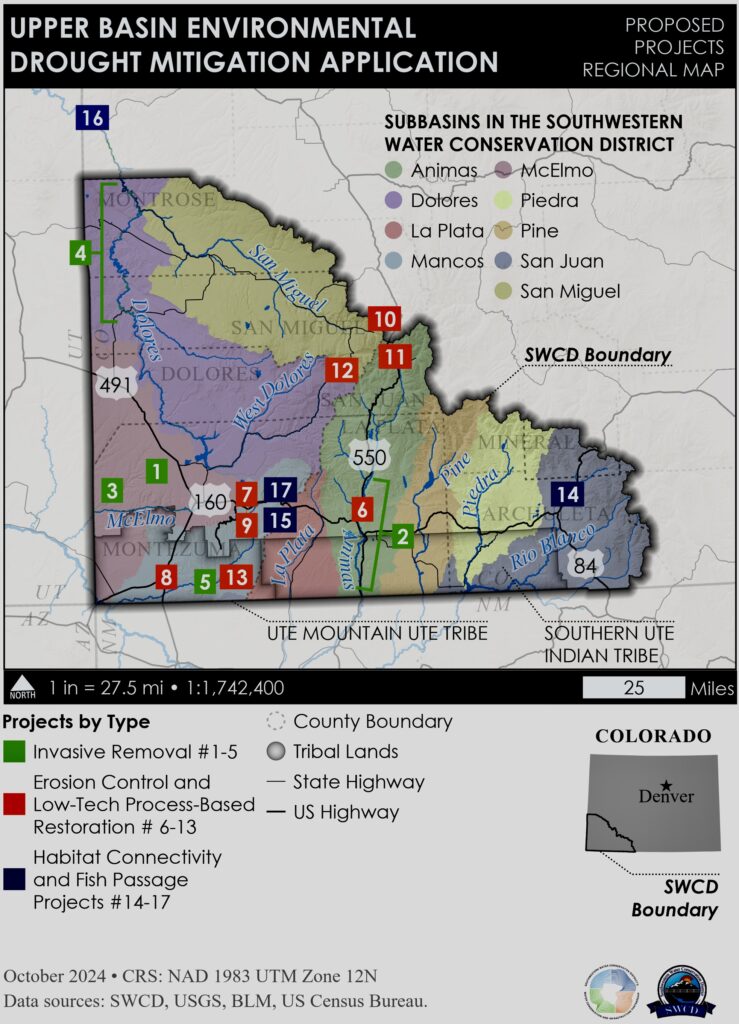With diminishing water availability in the West due to drought, there is an ongoing need to protect water while maintaining the economic viability of local communities. That’s where the Southwestern Water Conservation District (SWCD) Water Conservation and Infrastructure Partnership comes in. The partnership is a robust collaboration led by SWCD and involves over 30 entities throughout southwest Colorado. It focuses on increasing the capacity in southwest Colorado for resilience projects by bundling partner projects together to improve funding access and address some of the most pressing and damaging impacts of drought on the region.
On behalf of the Partnership, SWCD has created a bundle of 17 multi-benefit projects that restore ecosystems and habitats impacted by drought, improving community welfare, resilience to flood and wildfire, recreational access, and bolstering economic benefits. The projects will:
- Restore over 1,335 acres of riparian ecosystem;
- Reconnect over 200 miles of river; and
- Provide six basins with funding to help mitigate drought.
“Southwestern saw the need and an opportunity to bundle projects to be more competitive and help local stakeholder groups access federal funding,” said Steve Wolff, Southwestern Water Conservation District General Manager.
“We look forward to putting this unprecedented federal funding to work for drought resilience in Southwest Colorado. We want to acknowledge the Southwestern Board for their leadership, the Partnership for their enthusiasm and collaboration in putting this program together, and CWCB for their financial support”.

Projects in the bundle span three major categories:
- Invasive Plant Removal – Across five projects, partners will remove and treat 1,310 acres of invasive plants, replant and seed 10 acres of native vegetation, and install 130 structures made of natural materials, such as wood and rocks. These projects will reduce the impacts of wildfire, bolster water quality, and support river and landscape health in the face of drought and higher temperatures.
- Erosion Control and Low-Tech Process-Based Restoration – Partners will pursue eight projects to enhance over 10 miles of stream with 14 acres of riverside habitat, restore 13 acres of fens, and include 202 low-tech process-based restoration structures. The projects will enhance water retention, groundwater recharge, floodplain reconnection, and watershed resilience, while addressing erosion issues caused by drought and reduced river flows. Projects located in headwater systems will address water quality issues from legacy mining, which are exacerbated by drought during low flows. Lower elevation projects will enhance habitat connectivity.
- Habitat Connectivity and Fish Passage: These four projects will connect over 200 river miles by creating permanent fish passages at three improved diversion structures and restoring 3/4 of a mile of instream habitat. The projects enhance the migration ability of five fish species of concern, including the endangered Colorado Pikeminnow and Razorback Sucker. The projects in this category will help the fish thrive in the face of drought, higher temperatures, and reduced river flows.
The Southwestern Water Conservation District Water Conservation and Infrastructure Partnership is supported by 37 different federal, state, and local agencies representing local and regional water agencies, environmental organizations, Tribal Councils, and other stakeholders. Project proponents include the Animas Watershed Partnership, the Bureau of Land Management, Colorado Parks and Wildlife, Mancos Conservation District, Mountain Studies Institute, National Forest Foundation, RiversEdge West, Webber Ditch Company, Upper San Juan Watershed Enhancement Project, and the Ute Mountain Ute Tribe, among others.
The total estimated cost to complete the proposed work is $29,314,932, with $3,711,702 in non-federal support provided through grants and in-kind resources, as well as technical assistance from project partners and stakeholders. SWCD requested $25,603,230 from the Bureau of Reclamation to complete the scope of work identified in the proposal.
While funding for this effort was awarded in January of 2025 through the Upper Basin Environmental Drought Mitigation (B2E) Funding allocated through the Inflation Reduction Act, funds have been placed on hold with no contracting since the award date. To date, the effort has received matching cash and in-kind funds from the state, Tribes, water districts, and non-profit partners.
